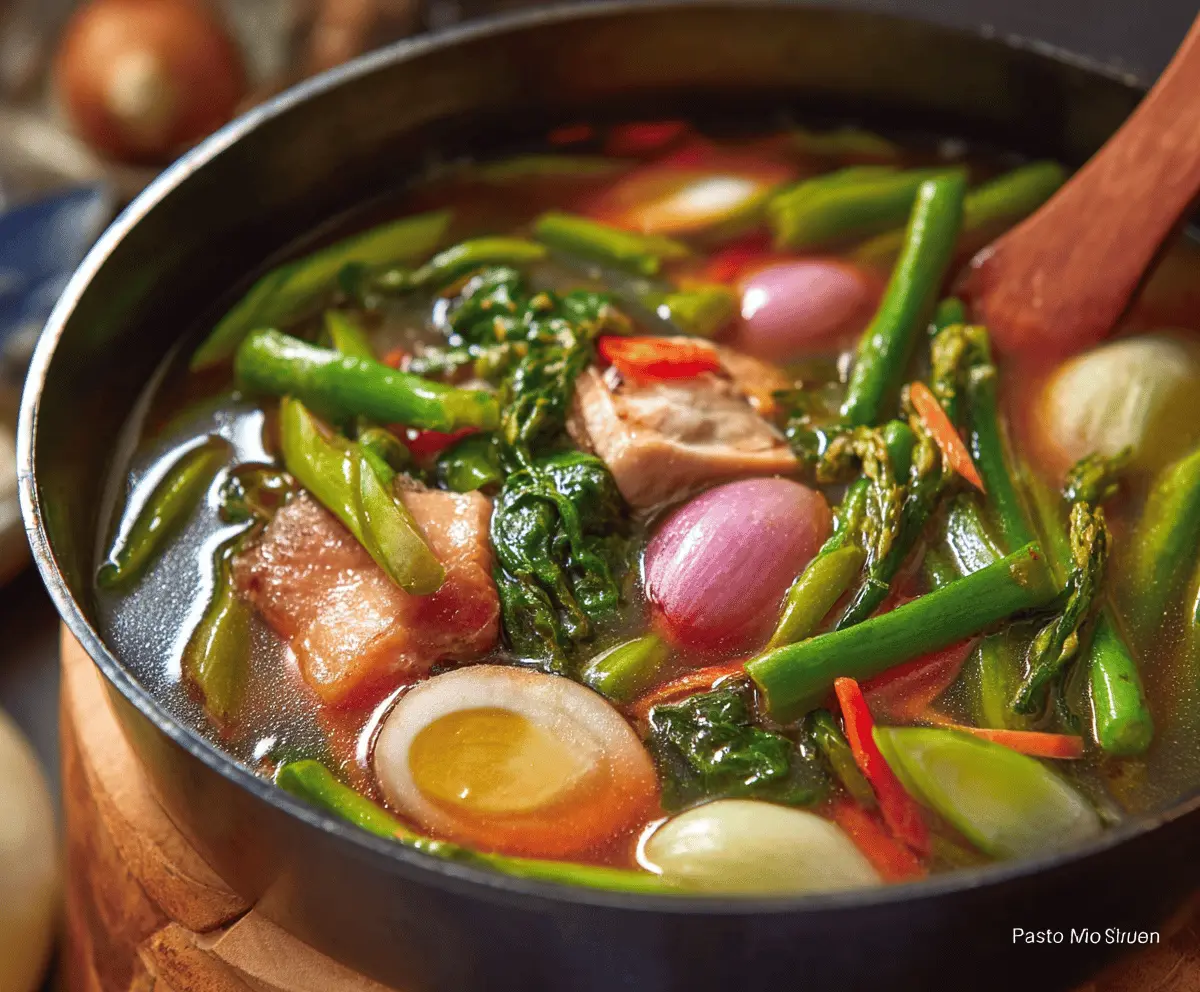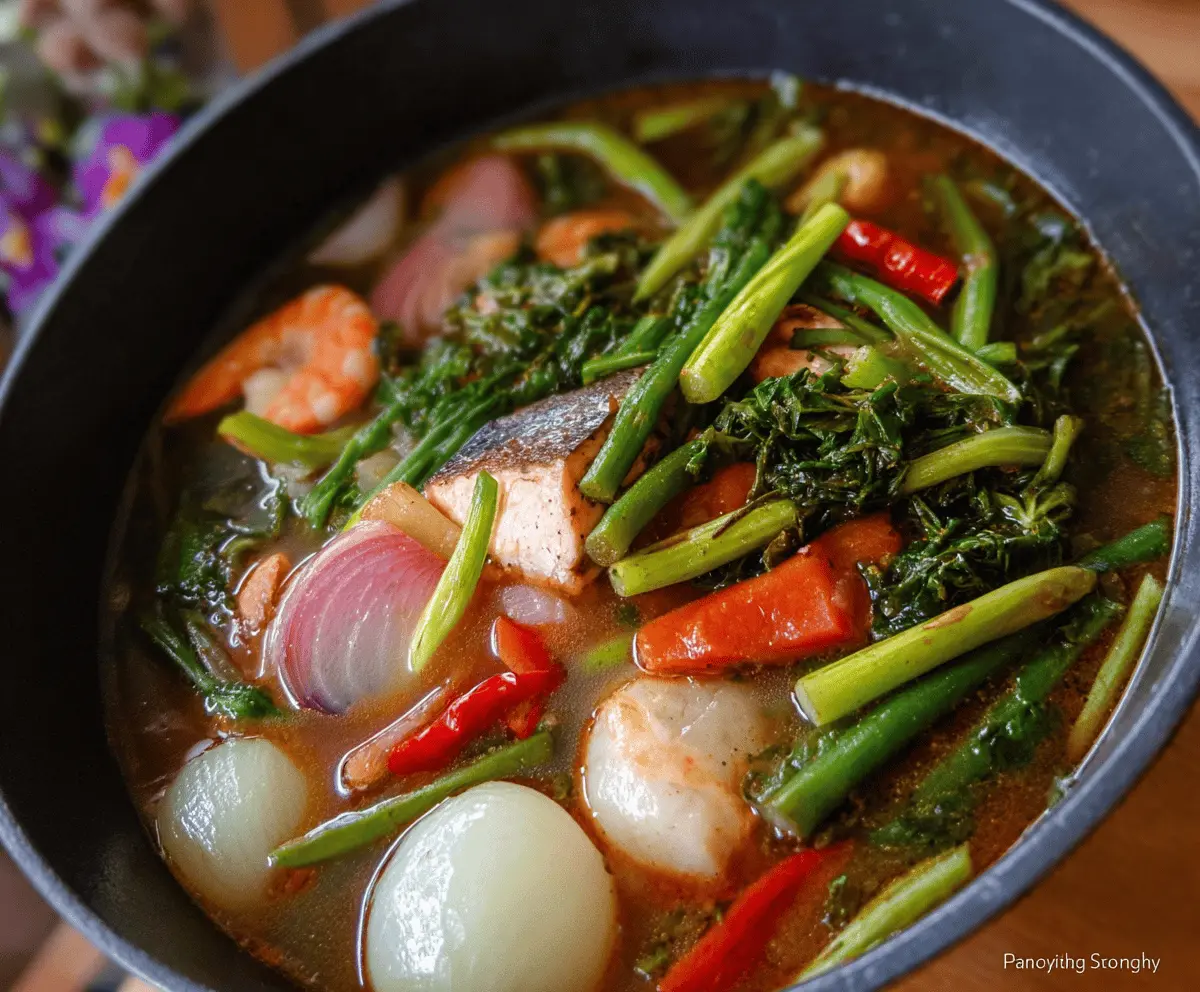Pork Sinigang is a warm and tangy soup that’s perfect for any day. With tender pork and a mix of fresh veggies, it’s bursting with flavor that’ll make your taste buds happy!
This dish is like a hug in a bowl! The sour taste from tamarind really brings everything together. I love serving it with rice for a comforting meal that’s super easy to make.
Key Ingredients & Substitutions
Pork: Pork belly or shoulder are my favorites for sinigang because they offer great flavor and tenderness. If you’re looking for a leaner option, you could try pork loin or even chicken. Just keep in mind that cooking times may vary.
Tamarind: The tartness from tamarind is what makes sinigang unique. If you don’t have the soup base mix, fresh tamarind is excellent. You can also use calamansi or lemon juice as substitutes, though the flavor will shift slightly.
Vegetables: Radish and eggplant are classic choices for this soup. If you can’t find them, feel free to add other veggies like bok choy or carrots. Just remember that some veggies cook faster than others, so add them accordingly.
Kangkong: Water spinach is traditional, but if you’re unable to get it, spinach works just as well. Other greens like bok choy can also provide a nice touch.
How Do I Get the Perfect Broth?
The broth is the heart of sinigang, and making it rich and tasty is essential. Here’s how to achieve it!
- Start by boiling your pork with water. When it reaches a boil, reduce the heat to medium to let it simmer gently.
- Skim off the scum that forms on top. This keeps your broth clear and clean-tasting.
- Adding onions and tomatoes early helps build the flavor. They break down and release sweetness, balancing the sourness from tamarind.
- Seasoning is key! Taste the broth as you go, and adjust with fish sauce for depth of flavor.

How to Make Pork Sinigang
Ingredients You’ll Need:
For the Soup:
- 2 lbs pork (cut into chunks, preferably pork belly or pork shoulder)
- 8 cups water
- 1 large onion, quartered
- 2 medium tomatoes, quartered
For the Vegetables:
- 1 cup radish, sliced
- 1 cup string beans, cut into 2-inch pieces
- 1 cup eggplant, sliced
- 1 cup kangkong (water spinach) or spinach
- 2-3 green chili peppers
For the Flavor:
- 1 packet tamarind soup base mix (or 1 cup fresh tamarind juice/paste)
- 2 tablespoons fish sauce (patis)
- Salt and pepper to taste
How Much Time Will You Need?
This Pork Sinigang will take around 1 hour to prepare and cook, with about 45 minutes for simmering the pork. You can have a comforting bowl of sinigang ready in no time!
Step-by-Step Instructions:
1. Boiling the Pork:
In a large pot, combine the pork and water. Bring it to a boil over medium heat, then reduce to a steady simmer. This helps to tenderize the pork and build a flavorful broth.
2. Skimming the Broth:
As the pork cooks, you’ll notice some scum or impurities rising to the surface. Use a ladle or spoon to skim this off. Keeping your broth clear makes it look and taste better!
3. Adding the Aromatics:
Next, add the quartered onions and tomatoes to the pot. Let these simmer for about 45 minutes. They’ll add a lovely depth of flavor to the broth while the pork becomes tender.
4. Incorporating the Sour Flavor:
Once the pork is tender, stir in the tamarind soup base mix or fresh tamarind juice. This is what gives sinigang its famous sour taste. Mix it well!
5. Adding Radish:
Now, add the sliced radish to the pot. Let it simmer for about 5 minutes until it starts to soften.
6. Cooking the Remaining Vegetables:
Next, throw in the string beans, eggplant, and green chili peppers. Continue to cook for another 5-7 minutes, until all the veggies are tender but still vibrant.
7. Seasoning to Perfection:
Season your soup with fish sauce, salt, and pepper to taste. This is where you give your sinigang the delicious flavors that suit your palate!
8. Adding the Greens:
Finally, add the kangkong or spinach to your pot and cook for 1-2 minutes, just until wilted. This will brighten up the dish and add freshness.
9. Serving Up:
Remove the pot from the heat and serve your Pork Sinigang hot with a side of steamed rice. Enjoy this warm, comforting dish with family and friends!
Feel free to adjust ingredients based on personal preference. Dig in and savor every delightful spoonful!

Can I Use Different Types of Pork for Sinigang?
Absolutely! While pork belly and shoulder are traditional, you can use pork loin or even spare ribs. Just note that the cooking times may vary based on the cut you choose. Just ensure that the meat is tender!
What Can I Use if I Can’t Find Tamarind?
If you can’t find tamarind paste or soup base mix, you can substitute it with lemon or calamansi juice. Start with a tablespoon and adjust to your preferred sourness. Just remember that it may alter the flavor slightly from the traditional recipe.
How Should I Store Leftovers?
Store any leftover sinigang in an airtight container in the fridge for up to 3 days. To reheat, warm it gently over low heat on the stove or in the microwave, adding a splash of water if it gets too thick.
Can I Add More Vegetables?
Definitely! Sinigang is versatile, so feel free to add veggies like bok choy, carrots, or even potatoes. Just remember to add them at the right time based on their cooking time to ensure everything remains tender and delicious!


